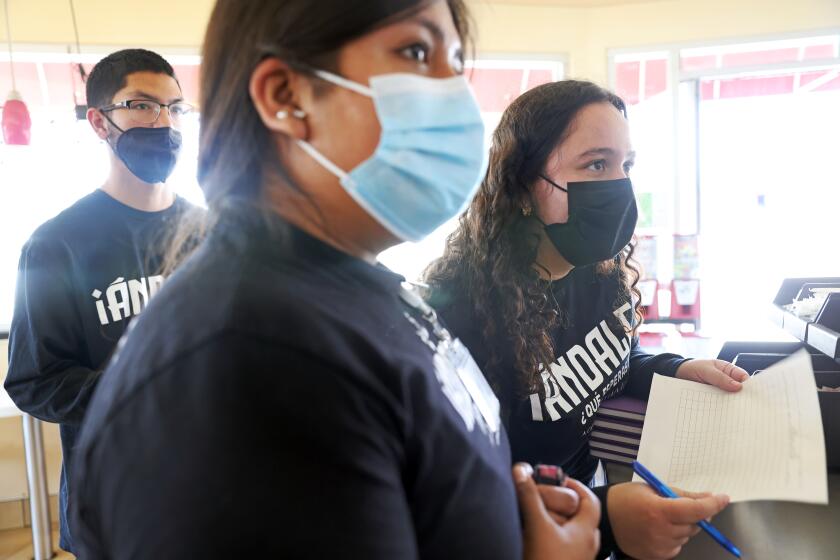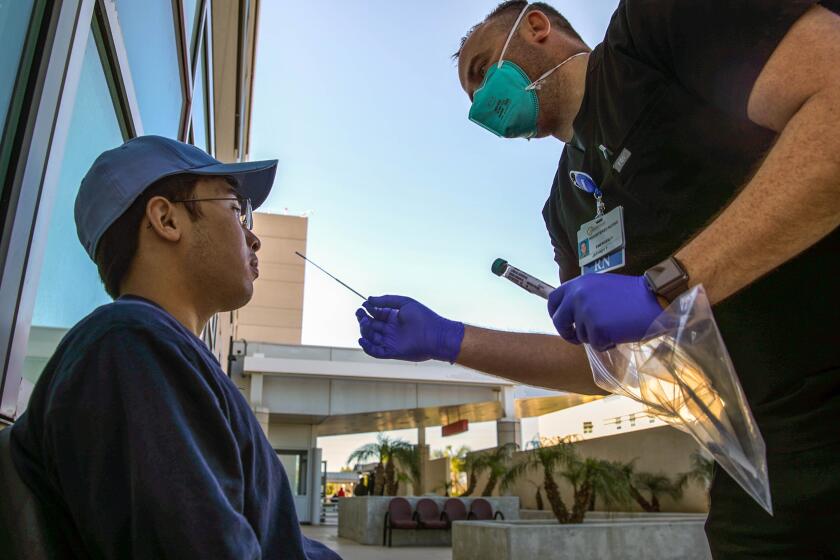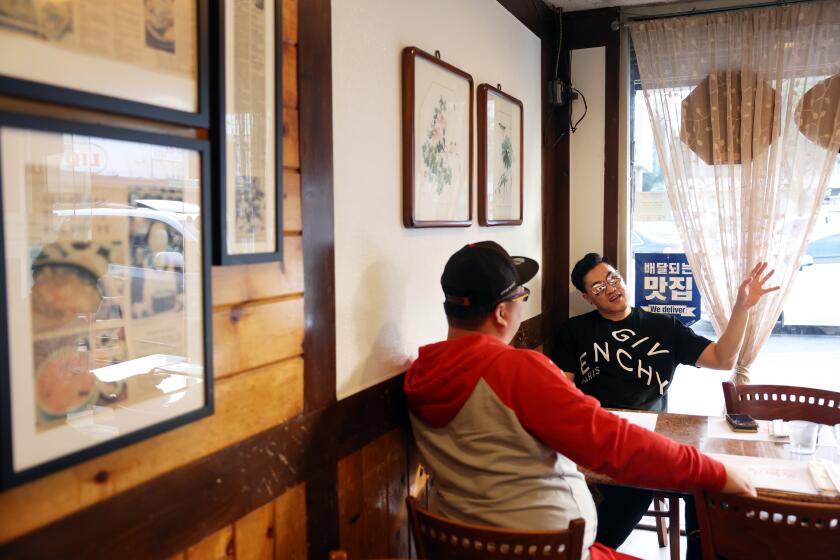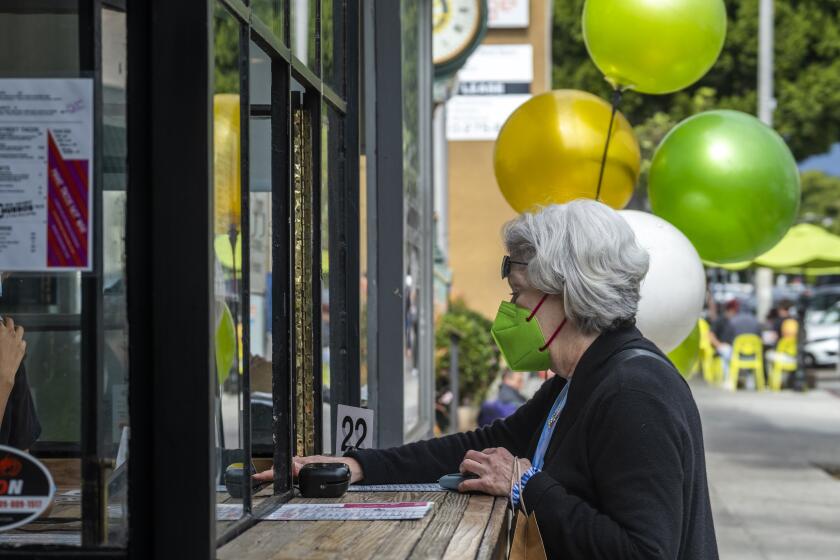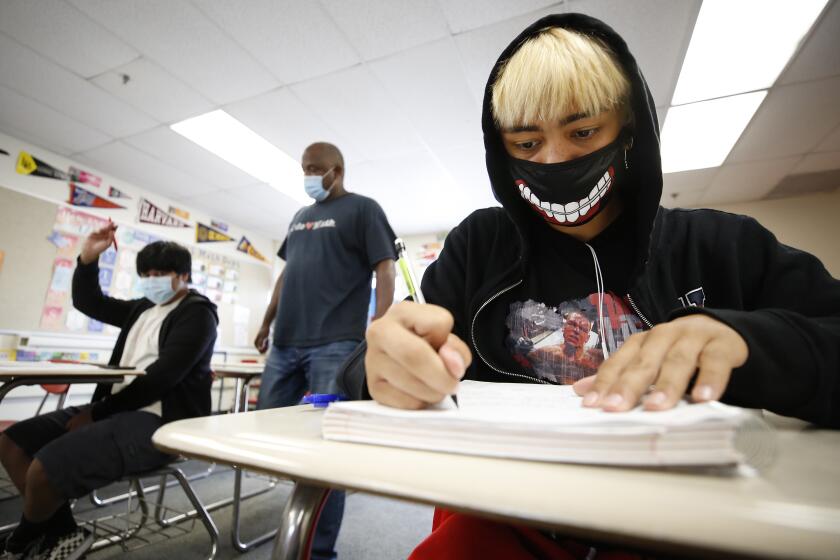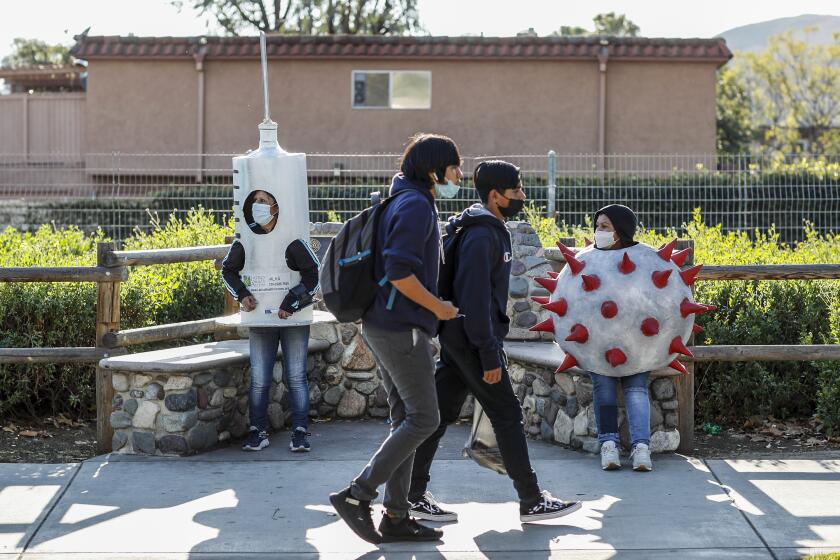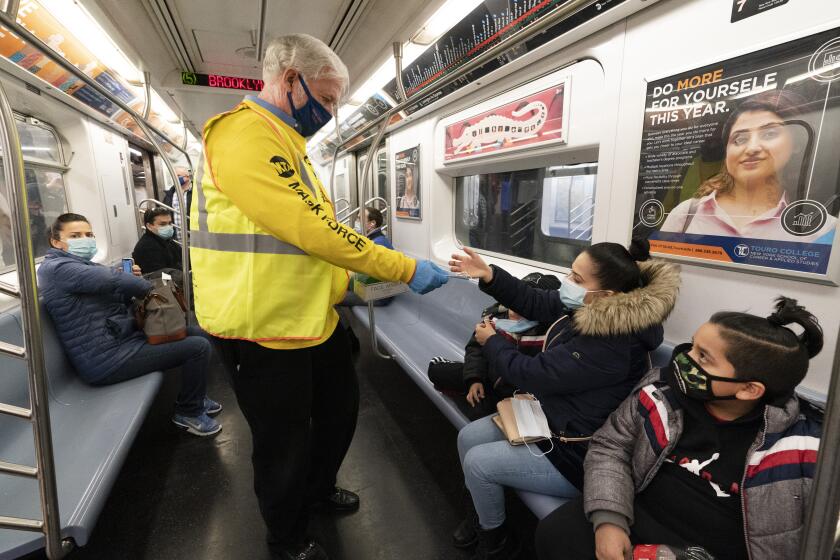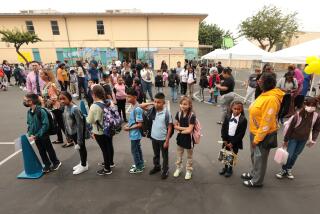‘Deltacron’ is hybrid of Delta and Omicron variants. How afraid should California be?
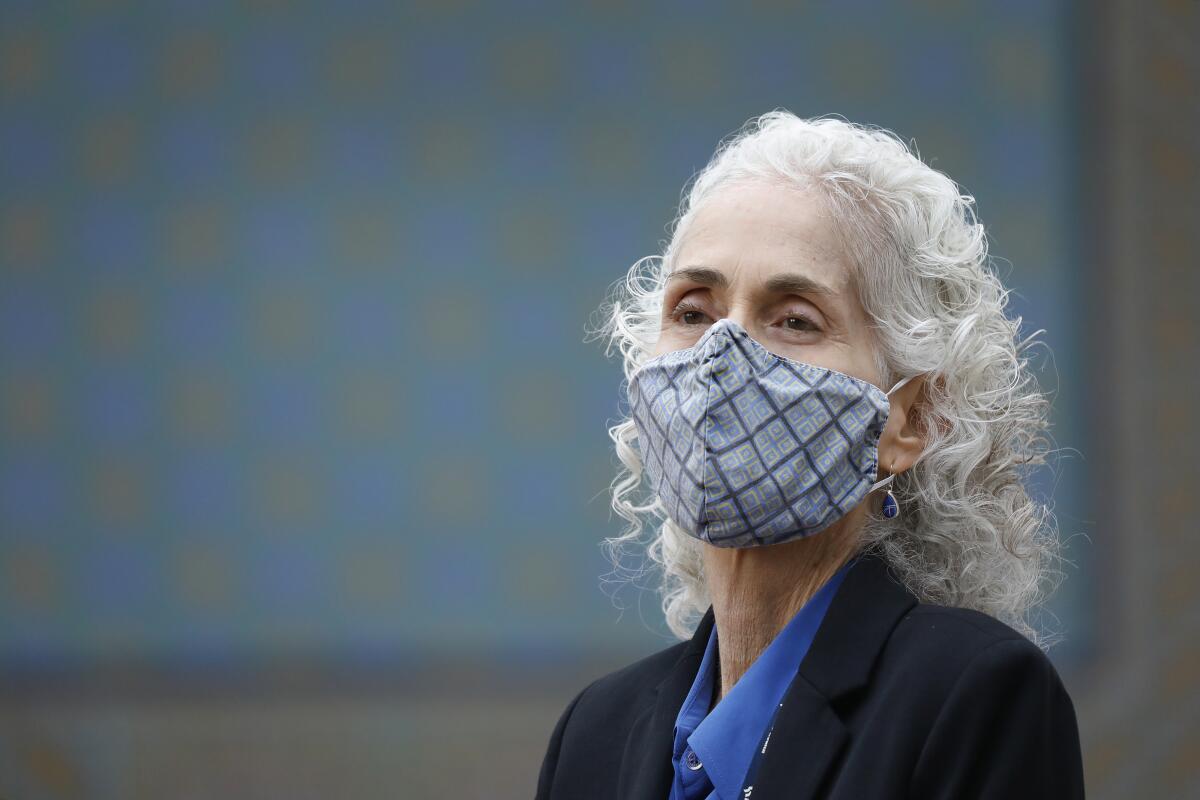
- Share via
As the latest coronavirus surge fades, health officials are keeping watch on a new mishmash of the Delta and Omicron variants.
Dubbed “Deltacron” by some, it’s essentially a blend of both the variants that fueled last summer’s and this winter’s COVID-19 waves, California State Epidemiologist Dr. Erica Pan said in a briefing to the California Medical Assn. this week.
But this coronavirus crossover event isn’t setting off blaring alarm bells among health officials just yet. Only a handful of cases have been documented nationwide, including at least one in California, Pan said.
‘We’re monitoring this closely’
And so far, neither the U.S. Centers for Disease Control and Prevention nor the World Health Organization has deemed it necessary to classify Deltacron as a variant of either interest or concern — labels that are reserved for strains with particularly troubling characteristics, such as the ability to spread more easily, cause more severe illness or better evade the protection afforded by vaccines.
Based on the available clinical and epidemiological data, Pan said she isn’t concerned about Deltacron at this moment. But, she added, “it is, to us, a harbinger, that the next one will come. We just don’t know when, and we’re monitoring this closely.”
The county still needs to be prepared for worst-case scenarios, officials said.
Deltacron has gained greater attention following a recent broadcast of “60 Minutes” — which aired tape of CDC Director Dr. Rochelle Walensky asking about it during a staff meeting. A staff member replied that Deltacron was “out there, but we’re still in the, like, handful of cases.”
The latest variant has not been detected in Los Angeles County, according to Public Health Director Barbara Ferrer.
“We don’t have any evidence yet that this is circulating widely, or even in any small numbers, to know what the implications might be,” she said.
As is the case with any new variant or subvariant, the biggest question will be whether available COVID-19 vaccines will still provide a high degree of protection. But with such small numbers of Deltacron nationwide, it’s hard to get an answer to that question at this time, Ferrer said.
California has identified a number of cases of BA.2, a sublineage of the Omicron variant. How concerned should we be?
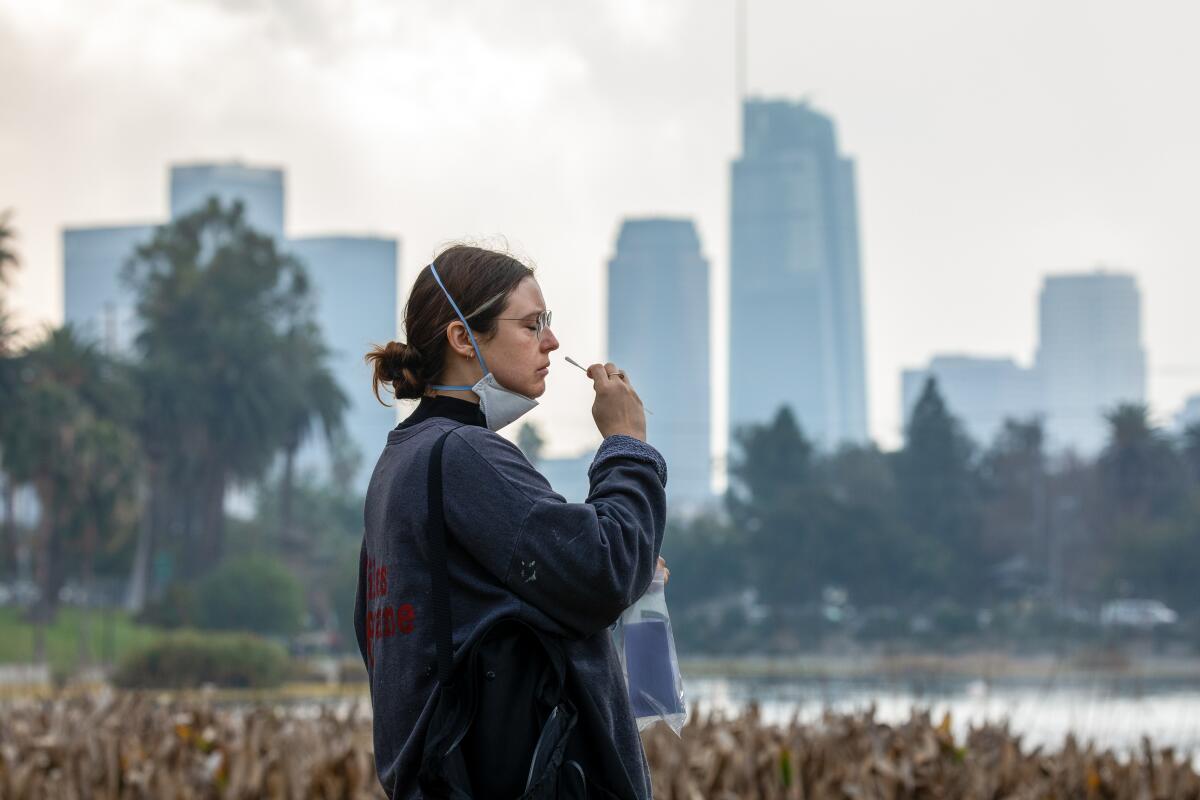
Deltacron vs. BA.2
Deltacron is distinct from BA.2, a sublineage of Omicron that has gained attention in recent weeks. Pan said some experts suggest BA.2 should be treated as a variant distinct from Omicron, “because it’s so different when you look at the genomic trees to the other Omicron variants.”
Pan said California is seeing increases in cases of BA.2, and there are higher proportions of this sublineage in wastewater samples. But so far, officials haven’t expressed much concern about it.
“There’s definitely data out there that BA.2 is more infectious but not necessarily more severe,” Pan said.
BA.2 is believed to be 30% more infectious than BA.1, the dominant Omicron subvariant, Ferrer said. So far in L.A. County, BA.2 has been identified in 231 analyzed Omicron cases.
“While BA.2 is slowly increasing in the county, it still makes up a very small proportion of all sequenced cases, accounting for just under 5% of sequenced samples for the week ending Feb. 19,” Ferrer said.
Los Angeles moves to lift vaccination verification requirement at restaurants, bars, hair salons, gyms and movie theaters.
Trends looking good
Overall, the outlook remains bright for Los Angeles County, as coronavirus cases and hospitalizations continue to decline. L.A. County’s COVID-19 community level — a CDC-defined indication of strain on hospitals — is considered low.
But coronavirus transmission levels remain substantial, at 89 cases a week for every 100,000 residents, according to CDC data published Thursday. That “means there’s just a fair amount of virus still circulating,” Ferrer said at a news briefing, and is a key reason why she’s strongly recommending universal masking for everyone in indoor public settings for now.
Before the CDC unveiled its community level framework in late February, L.A. County health officials had said masks would still be required in indoor public places until coronavirus transmission fell below 50 cases a week for every 100,000 residents.
The new system sorts counties into a low, medium or high category based on coronavirus case and hospitalization rates, as well as the share of inpatient beds that are occupied by COVID-19 patients. Federal health officials do not recommend universal indoor masking for counties within the medium or low categories, like L.A. County.
In light of this shift, L.A. County eased its indoor mask requirement last week. However, that’s not to say that residents shouldn’t still avail themselves of face coverings considering the amount of coronavirus that’s still circulating in the community.
“I’m very clear about what I think is the safest way to get through the next few weeks, and that is to go ahead and keep a mask on,” Ferrer said in a recent interview.
Some doctors and public health experts are continuing to take COVID-19 precautions that go above and beyond the new minimum mandates.
L.A. County is averaging 39 COVID-19 deaths a day over the past week — down from an Omicron peak of 73 deaths a day in early February, but still higher than pre-Omicron surge levels of about 15 deaths a day. Although the reductions in daily deaths is encouraging, “it’s still disheartening that we’re continuing to lose so many residents to COVID-19,” Ferrer said.
Looking for upticks
Ferrer said county officials will also be monitoring to see if there’s an uptick in coronavirus outbreaks at K-12 school and child-care settings in the coming weeks. The state is lifting its mask mandate in indoor K-12 and child-care settings Friday night.
Some have voiced concerns especially about optional masking policies in daycares among kids under the age of 5, who are ineligible to be vaccinated, and especially in settings involving those under age 2, who cannot be masked due to the risk of suffocation.
Some studies have suggested that masks have proved to be beneficial in reducing coronavirus transmission in schools. A study published in the journal Pediatrics on Wednesday found that universal masking requirements were associated with a 72% reduction in coronavirus transmission within schools compared with those with optional masking policies.
California’s strict indoor mask rules at schools have helped prevent major coronavirus outbreaks on campuses.
The state’s lifting of the mask mandate in indoor K-12 and child-care settings has come amid worries voiced by some that mask policies might have a negative effect on a child learning how to talk.
In an explainer on its website, the American Academy of Pediatrics said, “while this is a natural concern, there is no known evidence that use of face masks interferes with speech and language development or social communication.”
“Consider this: visually impaired children develop speech and language skills at the same rate as their peers,” the academy said. “Young children will use other clues provided to them to understand and learn language. They will watch gestures, hear changes in tone of voice, see eyes convey emotions, and listen to words.”
California as a whole has seen tremendous improvement in its pandemic metrics in recent weeks. The numbers of new daily coronavirus cases and hospitalized COVID-19 patients have returned to pre-Omicron levels.
But, if past experiences are any indication, officials say the state should still be prepared for potential rebounds in coronavirus activity — particularly later in the summer, as children return for school; and around the fall and winter holiday season, where travel and gatherings are commonplace.
Moving on vs. moving forward
As Dr. Mark Ghaly, California’s health and human services secretary, said recently during a discussion hosted by the Sacramento Press Club: “I know some people wanted to focus on this concept of moving on. I like to think about moving forward.”
“We need to move forward and acknowledge that there’s a certain time and place for certain mitigation tools,” he said, and “we’ve gotten smarter and better through the pandemic on when and how to apply those tools.
Whatever the rules at the state or local level, individuals will also always have the option of taking additional preventative measures that make sense for them or their families. And, even though the state is no longer requiring public indoor masking, officials do still strongly recommend the practice.
But whether to follow that guidance is entirely up to individual Californians. “I know people like to focus on all of the folks who aren’t listening. But my sense is that many, many people are and those who are, are listening for a reason,” Ghaly said. “They believe that they’re at risk and they’re concerned.”
The case count is larger than the combined population of San Diego, Orange and Riverside counties, and equivalent to nearly 25% of Californians testing positive at some point in the past two-plus years.
The Centers for Disease Control and Prevention said it is developing guidance that will ease the mask mandate for public transit next month.
More to Read
Sign up for Essential California
The most important California stories and recommendations in your inbox every morning.
You may occasionally receive promotional content from the Los Angeles Times.
